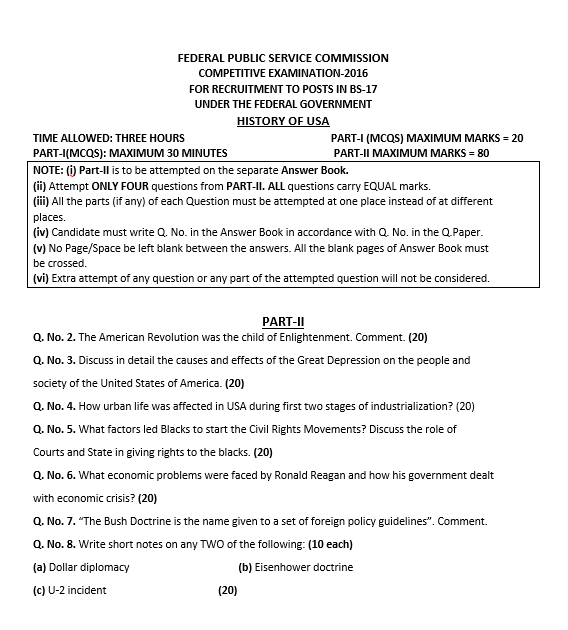History of USA 2016
No. 2. The American Revolution was the child of Enlightenment. Comment. (20)
No. 3. Discuss in detail the causes and effects of the Great Depression on the people and society of the United States of America. (20)
No. 4. How urban life was affected in the USA during the first two stages of industrialization? (20)
No. 5. What factors led Blacks to start the Civil Rights Movement? Discuss the role of Courts and State in giving rights to the blacks. (20)
No. 6. What economic problems were faced by Ronald Reagan and how his government deal with economic crisis? (20)
No. 7. “The Bush Doctrine is the name given to a set of foreign policy guidelines”. Comment.
No. 8. Write short notes on any TWO of the following: (10 each)
- Dollar diplomacy
- Eisenhower doctrine
- U-2 incident
Summaries of Questions:
No. 2. The American Revolution was the child of Enlightenment. Comment.
The American Revolution was heavily influenced by Enlightenment ideals like liberty, equality, and democracy. Thinkers such as Locke and Rousseau inspired the demand for independence, individual rights, and governance based on consent, shaping the revolution’s intellectual and philosophical foundation.
No. 3. Discuss in detail the causes and effects of the Great Depression on the people and society of the United States of America.
The Great Depression was caused by stock market crashes, bank failures, and economic mismanagement. It led to mass unemployment, homelessness, and economic disparity, drastically altering American society with widespread poverty and fostering reforms under Roosevelt’s New Deal.
No. 4. How was urban life affected in the USA during the first two stages of industrialization?
During early industrialization, urban areas expanded rapidly, leading to overcrowding, poor sanitation, and harsh labor conditions. In the second stage, technological advancements improved infrastructure, but urban inequalities and labor struggles persisted, reshaping cities into hubs of both opportunity and social challenges.
No. 5. What factors led Blacks to start the Civil Rights Movement? Discuss the role of Courts and State in giving rights to the blacks.
Segregation, systemic racism, and disenfranchisement pushed African Americans to initiate the Civil Rights Movement. Landmark rulings like Brown v. Board of Education and legislative measures such as the Civil Rights Act of 1964 reflected the courts’ and state’s role in securing their rights, although implementation faced resistance.
No. 6. What economic problems were faced by Ronald Reagan, and how did his government deal with the economic crisis?
Reagan faced high inflation, unemployment, and slow growth. His administration addressed these issues through Reaganomics, which emphasized tax cuts, reduced government spending, deregulation, and monetary policies. While it curbed inflation and boosted growth, it also increased income inequality and national debt.
No. 7. “The Bush Doctrine is the name given to a set of foreign policy guidelines.” Comment.
The Bush Doctrine prioritized preemptive action, unilateralism, and the spread of democracy, especially after 9/11. It justified interventions like the Iraq War, asserting that threats to US security must be neutralized proactively, reshaping America’s global strategy.
No. 8. Write short notes on any TWO of the following:
(a) Dollar Diplomacy: A policy by President Taft that aimed to promote US financial interests abroad by encouraging investments and economic influence rather than direct military intervention, especially in Latin America.
(b) Eisenhower Doctrine: Announced in 1957, it pledged US military and economic support to Middle Eastern countries resisting communist aggression, reflecting Cold War containment strategies.
(c) U-2 Incident: A 1960 diplomatic crisis caused by the USSR’s downing of a US spy plane, which escalated tensions during the Cold War and undermined trust between the superpowers.
